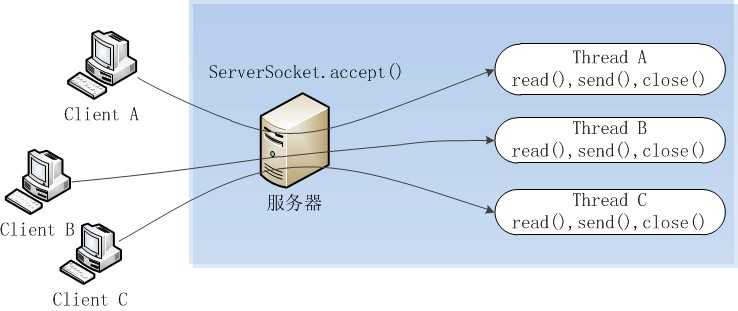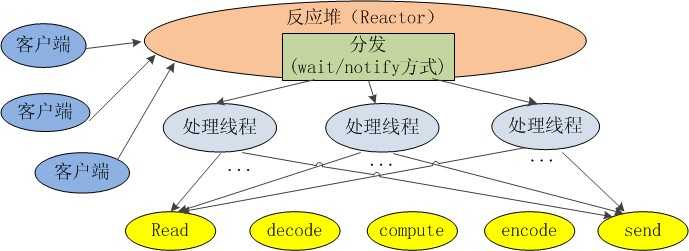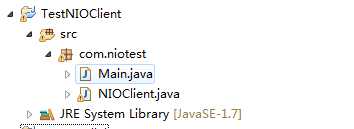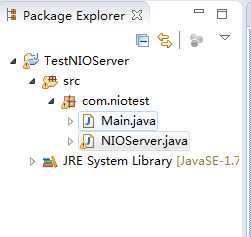标签:
Java NIO(New IO)是一个可以替代标准Java IO API的IO API(从Java 1.4开始),Java NIO提供了与标准IO不同的IO工作方式。
Java NIO: Channels and Buffers(通道和缓冲区)
标准的IO基于字节流和字符流进行操作的,而NIO是基于通道(Channel)和缓冲区(Buffer)进行操作,数据总是从通道读取到缓冲区中,或者从缓冲区写入到通道中。
Java NIO: Non-blocking IO(非阻塞IO)
Java NIO可以让你非阻塞的使用IO,例如:当线程从通道读取数据到缓冲区时,线程还是可以进行其他事情。当数据被写入到缓冲区时,线程可以继续处理它。从缓冲区写入通道也类似。
Java NIO: Selectors(选择器)
Java NIO引入了选择器的概念,选择器用于监听多个通道的事件(比如:连接打开,数据到达)。因此,单个的线程可以监听多个数据通道。
阻塞I/O在调用InputStream.read()方法时是阻塞的,它会一直等到数据到来时(或超时)才会返回;
同样,在调用ServerSocket.accept()方法时,也会一直阻塞到有客户端连接才会返回,每个客户端连接过来后,服务端都会启动一个线程去处理该客户端的请求。
阻塞I/O的通信模型示意图如下:

阻塞I/O存在一些缺点:
1. 当客户端多时,会创建大量的处理线程且每个线程都要占用栈空间和一些CPU时间;
2. 阻塞可能带来频繁的上下文切换,且大部分上下文切换可能是无意义的。
Java NIO是在jdk1.4开始使用的,它既可以说成“新I/O”,也可以说成非阻塞式I/O。
1. 由一个专门的线程来处理所有的 IO 事件,并负责分发。
2. 事件驱动机制:事件到的时候触发,而不是同步的去监视事件。
3. 线程通讯:线程之间通过 wait,notify 等方式通讯。保证每次上下文切换都是有意义的。减少无谓的线程切换。


NIOClient.java
package com.niotest; import java.io.IOException; import java.net.InetSocketAddress; import java.nio.ByteBuffer; import java.nio.channels.SelectionKey; import java.nio.channels.Selector; import java.nio.channels.ServerSocketChannel; import java.nio.channels.SocketChannel; import java.util.Iterator; public class NIOServer { /** * Selector(选择器)是Java NIO中能够检测一到多个NIO通道,并能够知晓通道是否为诸如读写事件做好准备的组件。这样,一个单独的线程可以管理多个channel,从而管理多个网络连接。 * ServerSocketChannel 是一个可以监听新进来的TCP连接的通道, 就像标准IO中的ServerSocket一样。ServerSocketChannel类在 java.nio.channels包中。 * */ public void listen(int port) throws IOException{ // Java NIO中的 ServerSocketChannel 是一个可以监听新进来的TCP连接的通道, 就像标准IO中的ServerSocket一样。ServerSocketChannel类在 java.nio.channels包中。 ServerSocketChannel serverSocketChannel= ServerSocketChannel.open(); // 为什么使用Selector? // 仅用单个线程来处理多个Channels的好处是,只需要更少的线程来处理通道。 // 事实上,可以只用一个线程处理所有的通道。 // 对于操作系统来说,线程之间上下文切换的开销很大,而且每个线程都要占用系统的一些资源(如内存)。因此,使用的线程越少越好。 // 但是,需要记住,现代的操作系统和CPU在多任务方面表现的越来越好,所以多线程的开销随着时间的推移,变得越来越小了。 // 实际上,如果一个CPU有多个内核,不使用多任务可能是在浪费CPU能力。 // Selector能够处理多个通道就足够了。 // Selector的创建:通过调用Selector.open()方法创建一个Selector Selector selector = Selector.open(); // 向Selector注册通道:为了将Channel和Selector配合使用,必须将channel注册到selector上。通过SelectableChannel.register()方法来实现。 // 设置通道为非阻塞 serverSocketChannel.configureBlocking(false); // 将该通道对应的ServerSocket绑定到port端口 serverSocketChannel.socket().bind(new InetSocketAddress(port)); // 注册该事件后,当该事件到达时,selector.select()会返回,如果该事件没到达selector.select()会一直阻塞。 serverSocketChannel.register(selector,SelectionKey.OP_ACCEPT); // 采用轮询的方式监听selector上是否有需要处理的事件,如果有,则进行处理 System.out.println("服务端启动成功 ... "); while (true) { //当注册的事件到达时,方法返回;否则,该方法会一直阻塞 selector.select(); // 获得selector中选中的项的迭代器,选中的项为注册的事件 Iterator iterator = selector.selectedKeys().iterator(); while (iterator.hasNext()) { SelectionKey key=(SelectionKey)iterator.next(); // 删除已选的key,以防重复处理 iterator.remove(); // 客户端请求连接事件 if(key.isAcceptable()){ ServerSocketChannel serverChannel=(ServerSocketChannel) key.channel(); // 获得和客户端连接的通道 SocketChannel clientConnectChannel = serverChannel.accept(); // 设置成非阻塞 clientConnectChannel.configureBlocking(false); //在这里可以给客户端发送信息哦 clientConnectChannel.write(ByteBuffer.wrap(new String("向客户端发送了一条信息").getBytes())); //在和客户端连接成功之后,为了可以接收到客户端的信息,需要给通道设置读的权限。 clientConnectChannel.register(selector, SelectionKey.OP_READ); } // 获得了可读的事件 else if(key.isReadable()){ // 服务器可读取消息,得到事件发生的Socket通道 SocketChannel channel = (SocketChannel)key.channel(); // 创建读取的缓冲区 ByteBuffer buffer = ByteBuffer.allocate(64); try{ channel.read(buffer); byte[] data = buffer.array(); String msg = new String(data).trim(); System.out.println("服务端收到信息:"+msg); ByteBuffer outBuffer = ByteBuffer.wrap("我(服务器端)已经接收到客户端消息".getBytes()); // 将消息回送给客户端 channel.write(outBuffer); }catch(IOException ex){ ex.printStackTrace(); }catch(Exception ex){ ex.printStackTrace(); } } } } } }
Main.java
package com.niotest; import java.io.IOException; public class Main { public static void main(String[] args) throws IOException { // TODO Auto-generated method stub NIOServer server=new NIOServer(); server.listen(8999); } }

NIOClient.java
package com.niotest; import java.io.IOException; import java.net.InetSocketAddress; import java.nio.ByteBuffer; import java.nio.channels.SelectionKey; import java.nio.channels.Selector; import java.nio.channels.SocketChannel; import java.util.Iterator; public class NIOClient { public void listen(String ip,int port) throws IOException { // 获得一个Socket通道 SocketChannel socketChannel=SocketChannel.open(); // 设置为非阻塞 socketChannel.configureBlocking(false); // 客户端连接服务器,其实方法执行并没有实现连接,需要在listen()方法中调 //用channel.finishConnect();才能完成连接 socketChannel.connect(new InetSocketAddress(ip,port)); // 获得一个通道管理器 Selector selector=Selector.open(); // 将通道管理器和该通道绑定,并为该通道注册SelectionKey.OP_CONNECT事件。 socketChannel.register(selector, SelectionKey.OP_CONNECT); // 采用轮询的方式监听selector上是否有需要处理的事件,如果有,则进行处理 // 轮询访问selector while (true) { selector.select(); // 获得selector中选中的项的迭代器 Iterator ite = selector.selectedKeys().iterator(); while (ite.hasNext()) { SelectionKey key = (SelectionKey) ite.next(); // 删除已选的key,以防重复处理 ite.remove(); // 连接事件发生 if (key.isConnectable()) { SocketChannel channel = (SocketChannel) key.channel(); // 如果正在连接,则完成连接 if(channel.isConnectionPending()){ channel.finishConnect(); } // 设置成非阻塞 channel.configureBlocking(false); //在这里可以给服务端发送信息哦 channel.write(ByteBuffer.wrap(new String("向服务端发送了一条信息").getBytes())); //在和服务端连接成功之后,为了可以接收到服务端的信息,需要给通道设置读的权限。 channel.register(selector, SelectionKey.OP_READ); } // 获得了可读的事件 else if (key.isReadable()) { // 服务器可读取消息,得到事件发生的Socket通道 SocketChannel channel = (SocketChannel)key.channel(); // 创建读取的缓冲区 ByteBuffer buffer = ByteBuffer.allocate(64); channel.read(buffer); byte[] data = buffer.array(); String msg = new String(data).trim(); System.out.println("客户端接收到服务器端消息:"+msg); // ByteBuffer outBuffer = ByteBuffer.wrap("我(客户端)已经收到服务器端消息".getBytes()); // // 将消息回送给服务器端 // channel.write(outBuffer); } } } } }
Main.java
package com.niotest; import java.io.IOException; public class Main { public static void main(String[] args) throws IOException { // TODO Auto-generated method stub NIOClient client=new NIOClient(); client.listen("127.0.0.1", 8999); } }
客户端结果:
客户端接收到服务器端消息:向客户端发送了一条信息
客户端接收到服务器端消息:我(服务器端)已经接收到客户端消息
服务器端结果:
服务端启动成功 ...
服务端收到信息:向服务端发送了一条信息
http://tutorials.jenkov.com/java-nio/index.html
http://ifeve.com/java-nio-all/
http://ifeve.com/selectors/
http://ifeve.com/server-socket-channel/
http://www.iteye.com/magazines/132-Java-NIO
本编学习主要参考:http://weixiaolu.iteye.com/blog/1479656
标签:
原文地址:http://www.cnblogs.com/yy3b2007com/p/5839124.html